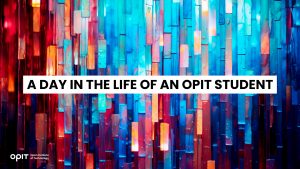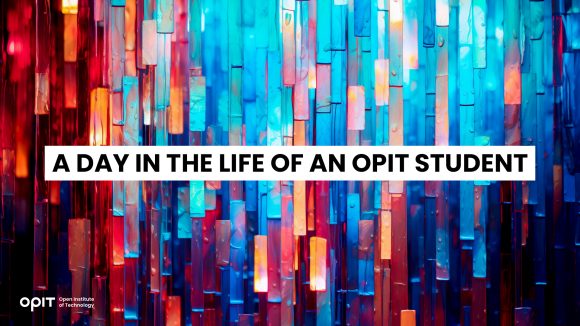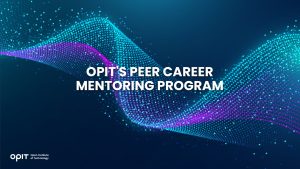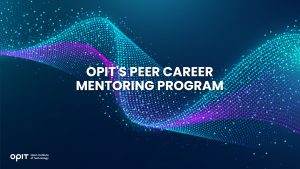

When it comes to traditional classroom learning, every day looks pretty much the same. You commute to your lectures, sit in a designated classroom, engage with your instructors and peers, and go home and study. This repetitive grind often leaves students yearning for a more dynamic and flexible educational experience.
Enter online learning.
When you study online, you have the freedom to craft your own schedule, escape the confining classroom setting, and explore diverse learning materials at your own pace.
Of course, this doesn’t mean your day shouldn’t be structured and well-organized. It just means that online learning firmly puts the reins of your education in your hands, allowing you to decide when, where, and how you engage with your coursework.
With this in mind, let’s explore what a day in the life of an Open Institute of Technology (OPIT) student might look like.
How an OPIT Student Spends an Average Day
Before diving into the specifics, let’s get to know the online “classroom” OPIT students spend most of their days at – Canvas LMS (Learning Management System).
Canvas LMS is the world’s No. 1 teaching and learning software, revolutionizing the educational experience for OPIT students. This robust LMS serves as a virtual hub for all academic activities, from live lectures to discussion boards.
Canvas LMS checks all the boxes for an enjoyable learning experience – it’s user-friendly, easy to navigate, interactive, and adaptable. Talk about a superior alternative to a traditional classroom!
Without further ado, let’s visit this platform and commence our day of immersive virtual classes, interactive discussions, and self-paced study sessions.
1. Log In to the Canvas LMS
The great thing about online education is that you can start your day whenever you’d like. Still, most OPIT students visit their Canvas account in the morning to check important updates, assignments, and announcements. Of course, this visit can also jog their memory about upcoming deadlines and live sessions.
But doesn’t the platform get confusing with all these different elements?
Absolutely not!
Here’s a quick breakdown of what OPIT students see once they log in.
First up – the dashboard. This centralized hub provides a neat overview of all the courses our students are enrolled in. So, for instance, if the student is pursuing a Master’s Degree (MSc) in Enterprise Security, they’ll see courses like “Cybersecurity Fundamentals and Governance,” “Data Analytics and Risk Management,” and “Cryptography and Secure Communications.”
On the right, next to the dashboard, students can see all their to-do activities, such as live lectures, study sessions, and student mixers. With this handy list, OPIT allows students to always stay on top of their game, as keeping a to-do list is a huge must in online learning.
If we were to go to the left, we’d see an easy-to-follow menu with tabs like “Courses,” “Inbox,” and “Help.” But these don’t come into play just yet. OPIT students typically first check their “Calendar” tab.
Though keeping tabs on all the activities in the calendar is essential for a productive day, our students typically prioritize two – live sessions and assessments (with their due dates).
When there’s a live session, the entire day is centered around it to ensure active participation.
Let’s make our fictional day one of these days to make it more interesting. As an example, suppose the lecture starts at 7 p.m., which OPIT students can find out by clicking on the live session in the calendar. There will also be a Zoom link to facilitate easy access when the time comes.
As far as the assessments go, students should always make sure there aren’t any with due dates close together. If there are, they know what to do – tackle them on time and avoid any last-minute stress.
2. Check the Course Content
At this point, our student knows exactly what their day will look like. Since the focus of that day will be on the live session, it’s time to get acquainted with the course content relevant to the upcoming lecture.
A quick click on the course in question, followed by the “Modules” tab, is all it takes to access this content.
The “Module” tab offers a neat overview of all the past and upcoming modules, broken down into theoretical and practical portions. With well-thought-out overviews, PowerPoint presentations, and tutorials, OPIT students can prep for the live session hassle-free.
3. Start Studying
Now that our students know what to expect from the live session, it’s time to get down to focused studying. Since the live session is in the evening, there’s plenty of time to go over the new module, revise the past one(s), and solidify their understanding.
To make the most out of their study time, OPIT students usually plan it in advance, especially when they intend to work on more than one module at a time. This helps them stay on track and avoid the ever-so-tempting procrastination.
As far as the studying itself goes, it’s all up to our students. They can tackle the material in short bursts or dedicate larger blocks of time to focus on the matter at hand. Whatever works for them!
4. Ask for Help
With online learning and self-paced studying, it’s perfectly normal to encounter challenging concepts and have numerous questions in the process. Moreover, these questions don’t necessarily have to do anything with the course material. Students might struggle to organize their time, balance priorities, or adapt to the online learning environment itself. Whatever the case, we’ve got great news – OPIT has an incredible support system in place.
That’s why our students will take some time after their study session to schedule a meeting with Sara Ciabattoni, OPIT’s Class Coordinator. During this 20-minute meeting, they will greatly benefit from Sarah’s expertise and guidance, allowing them to return to their studies with renewed confidence.
Like everything in Canvas LMS, scheduling this meeting takes only a few clicks. Visit the Class Coordinator Virtual Office, choose your preferred date and time, hit “Next,” and you’re good to go. Upon confirmation, Sarah will provide all the necessary conferencing details. Best of all? The meeting will automatically be added to the student’s Google calendar, so there’s no need to deal with these technicalities.
5. Take a Break Before Live Session
At this point, the day has already been filled with lots of helpful activities, productive studying, and valuable preparation. Do you know what this means? That’s right – a break is well-deserved!
During the break, OPIT students can do virtually whatever they want. After all, they’re home or in their chosen environment. Most of them use the break to relax, do something enjoyable, or grab a meal. Some will even use it to change the scenery a little before the live session.
The great news is that Canvas can come with them wherever they go. Canvas LMS offers a nifty app that allows students to check their calendars, see relevant activities, and read notifications on the go. This adds another layer of flexibility to this already incredibly convenient learning experience.
6. Attend the Live Session
Cue a ringing school bell – it’s time for the live session!
By this time, our students have already found the perfect environment to immerse themselves in the live session. Once the session begins, they can actively listen, take notes, or ask questions. OPIT’s amazing faculty is there to facilitate an engaging and interactive learning experience with lots of valuable insights and guidance.
7. Check the Grades
Thanks to the revitalizing break before the live session, our students won’t be too tired for some more work even after the session has concluded. But first – a quick check of the grades.
Unsurprisingly, grades can be accessed in two clicks by visiting the tab of the same name under “Courses”. One more click is all it takes to understand how these grades have been earned.
8. Work on Assessments
Let’s say our student enjoys studying in the evening and has a lot of energy left after the live lecture. In that case, it’s time to tackle some assignments.
Since OPIT continually assesses its students instead of hitting them with one huge final, keeping up with assignments is crucial.
These assignments often call for teamwork, which Canvas makes easy. A visit to the “Collaborations” tab under “Courses” and a click on the “Start a New Collaboration” button can be the beginning of an incredibly fruitful collaboration.
OPIT students typically use WhatsApp to communicate outside the “official” Canvas and Slack platforms, so a quick message is enough to get all the teammates together.
9. Talk to a Career Advisor
OPIT students nearing the end of their academic journey at our institution typically have important decisions to make regarding their career paths. That’s why it’s perfectly normal to feel slightly anxious or overwhelmed at the end of the day.
So, let’s schedule a valuable one-on-one consultation with the Head of Career Services at OPIT before signing off. The unbelievably experienced Mike McCulloch is at our student’s disposal for any career-related concerns, guidance, or support.
10. Revel in a Day Well-Spent
At the end of such a day, all our students can do is pat themselves on the back. Here at OPIT, we’d like to believe we also have a part in this sense of achievement, thanks to the unparalleled flexibility, clarity, and support we offer.
But what will your typical day as an OPIT student look like? Start your academic journey at this prestigious institution to find out.
Related posts

Source:
- Raconteur, published on November 06th, 2025
Many firms have conducted successful Artificial Intelligence (AI) pilot projects, but scaling them across departments and workflows remains a challenge. Inference costs, data silos, talent gaps and poor alignment with business strategy are just some of the issues that leave organisations trapped in pilot purgatory. This inability to scale successful experiments means AI’s potential for improving enterprise efficiency, decision-making and innovation isn’t fully realised. So what’s the solution?
Although it’s not a magic bullet, an AI operating model is really the foundation for scaling pilot projects up to enterprise-wide deployments. Essentially it’s a structured framework that defines how the organisation develops, deploys and governs AI. By bringing together infrastructure, data, people, and governance in a flexible and secure way, it ensures that AI delivers value at scale while remaining ethical and compliant.
“A successful AI proof-of-concept is like building a single race car that can go fast,” says Professor Yu Xiong, chair of business analytics at the UK-based Surrey Business School. “An efficient AI technology operations model, however, is the entire system – the processes, tools, and team structures – for continuously manufacturing, maintaining, and safely operating an entire fleet of cars.”
But while the importance of this framework is clear, how should enterprises establish and embed it?
“It begins with a clear strategy that defines objectives, desired outcomes, and measurable success criteria, such as model performance, bias detection, and regulatory compliance metrics,” says Professor Azadeh Haratiannezhadi, co-founder of generative AI company Taktify and professor of generative AI in cybersecurity at OPIT – the Open Institute of Technology.
Platforms, tools and MLOps pipelines that enable models to be deployed, monitored and scaled in a safe and efficient way are also essential in practical terms.
“Tools and infrastructure must also be selected with transparency, cost, and governance in mind,” says Efrain Ruh, continental chief technology officer for Europe at Digitate. “Crucially, organisations need to continuously monitor the evolving AI landscape and adapt their models to new capabilities and market offerings.”
An open approach
The most effective AI operating models are also founded on openness, interoperability and modularity. Open source platforms and tools provide greater control over data, deployment environments and costs, for example. These characteristics can help enterprises to avoid vendor lock-in, successfully align AI to business culture and values, and embed it safely into cross-department workflows.
“Modularity and platformisation…avoids building isolated ‘silos’ for each project,” explains professor Xiong. “Instead, it provides a shared, reusable ‘AI platform’ that integrates toolchains for data preparation, model training, deployment, monitoring, and retraining. This drastically improves efficiency and reduces the cost of redundant work.”
A strong data strategy is equally vital for ensuring high-quality performance and reducing bias. Ideally, the AI operating model should be cloud and LLM agnostic too.
“This allows organisations to coordinate and orchestrate AI agents from various sources, whether that’s internal or 3rd party,” says Babak Hodjat, global chief technology officer of AI at Cognizant. “The interoperability also means businesses can adopt an agile iterative process for AI projects that is guided by measuring efficiency, productivity, and quality gains, while guaranteeing trust and safety are built into all elements of design and implementation.”
A robust AI operating model should feature clear objectives for compliance, security and data privacy, as well as accountability structures. Richard Corbridge, chief information officer of Segro, advises organisations to: “Start small with well-scoped pilots that solve real pain points, then bake in repeatable patterns, data contracts, test harnesses, explainability checks and rollback plans, so learning can be scaled without multiplying risk. If you don’t codify how models are approved, deployed, monitored and retired, you won’t get past pilot purgatory.”
Of course, technology alone can’t drive successful AI adoption at scale: the right skills and culture are also essential for embedding AI across the enterprise.
“Multidisciplinary teams that combine technical expertise in AI, security, and governance with deep business knowledge create a foundation for sustainable adoption,” says Professor Haratiannezhadi. “Ongoing training ensures staff acquire advanced AI skills while understanding associated risks and responsibilities.”
Ultimately, an AI operating model is the playbook that enables an enterprise to use AI responsibly and effectively at scale. By drawing together governance, technological infrastructure, cultural change and open collaboration, it supports the shift from isolated experiments to the kind of sustainable AI capability that can drive competitive advantage.
In other words, it’s the foundation for turning ambition into reality, and finally escaping pilot purgatory for good.

The Open Institute of Technology (OPIT) is the perfect place for those looking to master the core skills and gain the fundamental knowledge they need to enter the exciting and dynamic environment of the tech industry. While OPIT’s various degrees and courses unlock the doors to numerous careers, students may not know exactly which line of work they wish to enter, or how, exactly, to take the next steps.
That’s why, as well as providing exceptional online education in fields like Responsible AI, Computer Science, and Digital Business, OPIT also offers an array of career-related services, like the Peer Career Mentoring Program. Designed to provide the expert advice and support students need, this program helps students and alumni gain inspiration and insight to map out their future careers.
Introducing the OPIT Peer Career Mentoring Program
As the name implies, OPIT’s Peer Career Mentoring Program is about connecting students and alumni with experienced peers to provide insights, guidance, and mentorship and support their next steps on both a personal and professional level.
It provides a highly supportive and empowering space in which current and former learners can receive career-related advice and guidance, harnessing the rich and varied experiences of the OPIT community to accelerate growth and development.
Meet the Mentors
Plenty of experienced, expert mentors have already signed up to play their part in the Peer Career Mentoring Program at OPIT. They include managers, analysts, researchers, and more, all ready and eager to share the benefits of their experience and their unique perspectives on the tech industry, careers in tech, and the educational experience at OPIT.
Examples include:
- Marco Lorenzi: Having graduated from the MSc in Applied Data Science and AI program at OPIT, Marco has since progressed to a role as a Prompt Engineer at RWS Group and is passionate about supporting younger learners as they take their first steps into the workforce or seek career evolution.
- Antonio Amendolagine: Antonio graduated from the OPIT MSc in Applied Data Science and AI and currently works as a Product Marketing and CRM Manager with MER MEC SpA, focusing on international B2B businesses. Like other mentors in the program, he enjoys helping students feel more confident about achieving their future aims.
- Asya Mantovani: Asya took the MSc in Responsible AI program at OPIT before taking the next steps in her career as a Software Engineer with Accenture, one of the largest IT companies in the world, and a trusted partner of the institute. With a firm belief in knowledge-sharing and mutual support, she’s eager to help students progress and succeed.
The Value of the Peer Mentoring Program
The OPIT Peer Career Mentoring Program is an invaluable source of support, inspiration, motivation, and guidance for the many students and graduates of OPIT who feel the need for a helping hand or guiding light to help them find the way or make the right decisions moving forward. It’s a program built around the sharing of wisdom, skills, and insights, designed to empower all who take part.
Every student is different. Some have very clear, fixed, and firm objectives in mind for their futures. Others may have a slightly more vague outline of where they want to go and what they want to do. Others live more in the moment, focusing purely on the here and now, but not thinking too far ahead. All of these different types of people may need guidance and support from time to time, and peer mentoring provides that.
This program is also just one of many ways in which OPIT bridges the gaps between learners around the world, creating a whole community of students and educators, linked together by their shared passions for technology and development. So, even though you may study remotely at OPIT, you never need to feel alone or isolated from your peers.
Additional Career Services Offered by OPIT
The Peer Career Mentoring Program is just one part of the larger array of career services that students enjoy at the Open Institute of Technology.
- Career Coaching and Support: Students can schedule one-to-one sessions with the institute’s experts to receive insightful feedback, flexibly customized to their exact needs and situation. They can request resume audits, hone their interview skills, and develop action plans for the future, all with the help of experienced, expert coaches.
- Resource Hub: Maybe you need help differentiating between various career paths, or seeing where your degree might take you. Or you need a bit of assistance in handling the challenges of the job-hunting process. Either way, the OPIT Resource Hub contains the in-depth guides you need to get ahead and gain practical skills to confidently move forward.
- Career Events: Regularly, OPIT hosts online career event sessions with industry experts and leaders as guest speakers about the topics that most interest today’s tech students and graduates. You can join workshops to sharpen your skills and become a better prospect in the job market, or just listen to the lessons and insights of the pros.
- Internship Opportunities: There are few better ways to begin your professional journey than an internship at a top-tier company. OPIT unlocks the doors to numerous internship roles with trusted institute partners, as well as additional professional and project opportunities where you can get hands-on work experience at a high level.
In addition to the above, OPIT also teams up with an array of leading organizations around the world, including some of the biggest names, including AWS, Accenture, and Hype. Through this network of trust, OPIT facilitates students’ steps into the world of work.
Start Your Study Journey Today
As well as the Peer Career Mentoring Program, OPIT provides numerous other exciting advantages for those who enroll, including progressive assessments, round-the-clock support, affordable rates, and a team of international professors from top universities with real-world experience in technology. In short, it’s the perfect place to push forward and get the knowledge you need to succeed.
So, if you’re eager to become a tech leader of tomorrow, learn more about OPIT today.
Have questions?
Visit our FAQ page or get in touch with us!
Write us at +39 335 576 0263
Get in touch at hello@opit.com
Talk to one of our Study Advisors
We are international
We can speak in:


